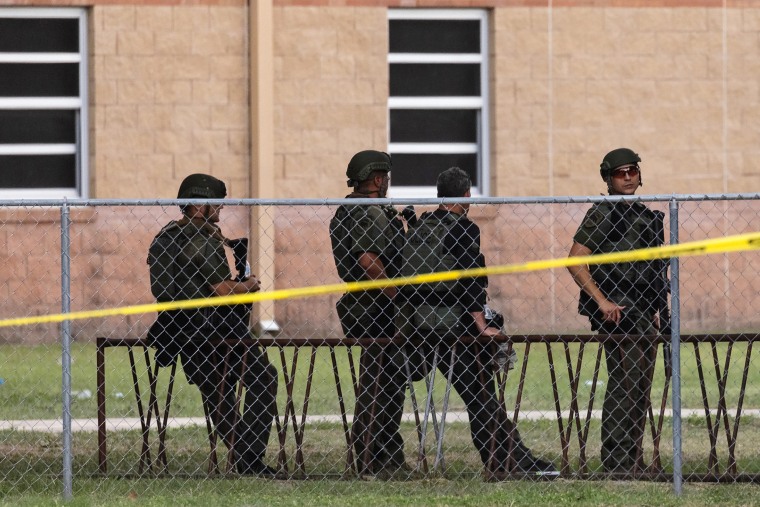Dramatic police bodycam video from the Uvalde school shooting that killed 19 children and two teachers in May shows multiple officers expressing confusion and doubt over the delay in moving in on the shooter.
“People are gonna ask why we’re taking so long,” an off-camera officer can be heard saying at one point, roughly an hour after officers first entered Robb Elementary School on May 24.
But despite a clear sense of urgency, in the end, it would take law enforcement more than an hour to take down the gunman in a police response that has been heavily criticized.
A scathing preliminary report released Sunday by the Texas House committee investigating the mass shooting found “systemic failure and egregiously poor decision making” by law enforcement and the school district.

Uvalde Mayor Don McLaughlin also announced Sunday that Uvalde’s acting chief of police, Lt. Mariano Pargas, has been placed on leave as the city investigates his response, as well as that of his officers.
In the string of body camera videos released by the Uvalde Police Department, officers can be seen smashing windows and helping children escape the deadly attack.
In one video captured early in the police response, shots can be heard ringing out inside the school.
“Am I bleeding?” the officer whose body camera captured the footage can be heard saying, with the video later showing blood on his hand and the officer saying he was bleeding from his ear.
After briefly exiting the school, he can then be heard telling arriving officers: “We got to get in there.”
“Guy’s inside the classroom right now,” he says of the shooter, Salvador Ramos, 18.
In another video released by the Uvalde Police Department on Sunday, an officer can be heard asking “What are we doing here?” around 20 minutes after appearing to arrive at the school.
Later in the video, authorities, including the Uvalde school district police chief, Pete Arredondo, can be seen struggling to find a key to get into a room near where the gunman was carrying out his assault.
An off-camera voice can later be heard trying to communicate with the gunman, saying: “Mr. Ramos, can you hear us? Mr. Ramos?” addressing the shooter. “Please don’t hurt anyone. These are innocent children. Please put your firearm down. We don’t want anyone else hurt.”
As several minutes pass by, Arredondo, who has been on administrative leave from the Uvalde Consolidated Independent School District since June 22, notes that officers are still having trouble getting into the room they are trying to access.
“We’re having a problem getting into the f------ room because it’s locked,” he says.
In the 77-page report from the Texas House committee investigating the shooting, authors says that beyond the gunman, no one else is to blame for the massacre. But, while it said, “there is no one to whom we can attribute malice or ill motives,” it highlighted “systemic failures and egregiously poor decision making” that may have affected the outcome.
Among those failings, the report said officers had assumed classroom doors were locked without seeing if that was true. It was not immediately clear if that was the case for the door Arredondo and other officers were trying to open.
However, the report noted that the door of Room 111, one of the two rooms in which the shooter was active, “probably was not effectively locked shut.”
The report also blamed the school’s infrastructure, as well as administrators for communication and logistical failures, that it said allowed the gunman to easily enter the building.
It further noted that the attacker would have fired “most of his shots” before law enforcement stepped into the building.
“Because of these failures of facilities maintenance and advance preparation, the attacker fired most of his shots and likely murdered most of his innocent victims before any responder set foot in the building,” the report said.
“Of the approximately 142 rounds the attacker fired inside the building, it is almost certain that he rapidly fired over 100 of those rounds before any officer entered,” it said.
“According to an analysis provided to the Committee, after entering the attacker spent about 2½ minutes rapidly firing over 100 rounds between the two rooms, 139 ultimately killing many innocent victims," it said.
After the attacker had already fired more than 100 shots in the elementary school's west building, two separate groups of officers “converged on the building at the same time from different directions,” it said. “From the time of their initial entry and over the course of the next five minutes, the attacker fired approximately 16 additional rounds.”
Speaking at a news conference Sunday, Mayor McLaughlin said he believed the police body camera footage provided "further necessary context" into the police response to the school massacre.
CORRECTION (July 18, 2022, 8.30 a.m. ET): A previous version of this article misstated Pete Arredondo’s title. He is the Uvalde school district police chief, not the Texas police chief.
